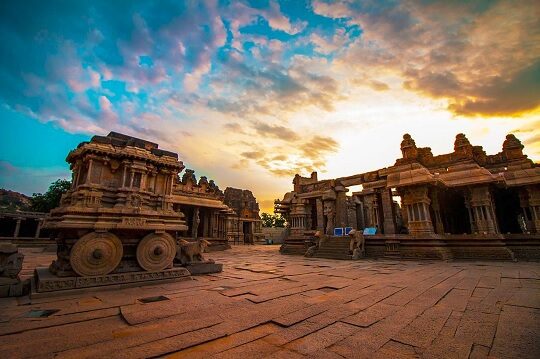The Reserve Bank of India will shortly issue 50 Rs notes in the Mahatma Gandhi (New) Series, bearing the signature of Dr. Urjit R. Patel, Governor, Reserve Bank of India. All the banknotes in the denomination of ₹ 50 issued by the Reserve Bank in the earlier series will continue to be legal tender. The base colour of the note is Fluorescent Blue. The new denomination has the motif of Hampi with Chariot on the reverse. The note has other designs, geometric patterns aligning with the overall colour scheme, both at the obverse and reverse. This article talks about new 50Rs notes, how do the new 50 Rs notes compare with old 50 Rs notes. It gives an overview of Hampi the motif of which appears in the new Rs 50 notes.
Salient Features of new 50 Rs Notes
The dimension of the banknote will be 66 mm x 135 mm.
Obverse (Front) of new 50 Rs Note
1. See through register with denominational numeral 50,
2. Denominational numeral ५० in Devnagari,
3. Portrait of Mahatma Gandhi at the centre,
4. Micro letters ‘RBI’, ‘भारत’, ‘INDIA’ and ‘50’,
5. Windowed demetalised security thread with inscriptions ‘भारत’ and RBI,
6. Guarantee Clause, Governor’s signature with Promise Clause and RBI emblem towards right of Mahatma Gandhi portrait,
7. Ashoka Pillar emblem on the right,
8. Mahatma Gandhi portrait and electrotype (50) watermarks,
9. Number panel with numerals growing from small to big on the top left side and bottom right side.
Reverse (Back) of new 50 Rs Note
10. Year of printing of the note on the left,
11. Swachh Bharat logo with slogan,
12. Language panel,
13. Motif of Hampi with Chariot,
14. Denominational numeral ५० in Devnagari.
Rs. 50 note were first introduced in 1975.
Comparing Old and New 50 Rs Notes
The ₹50 banknote of the Mahatma Gandhi Series is 147 × 73 mm. Pink-violet coloured, with the obverse side featuring a portrait of Mahatma Gandhi with a signature of the governor of Reserve Bank of India. It has the Braille feature to assist the visually challenged in identifying the currency. The reverse side features a motif of the Indian Parliament building.
The following images show old and new Rs 50 note
- Dimensions: New note : 66 mm x 135 mm Old note : 73 mm X 147 mm
- The image on the back of the currency. The old Rs 50 note had an image of Indian Parliament with a hoisted flag on the flagpole while the new Rs 50 note has a Hampi chariot motif.
- Unlike the old note, the new Rs 50 note has denominational number 50 in Devanagari script.
- The base colour of the new Rs 50 denomination is fluorescent blue compared to the light pink and white base in the old note.
- The image of Mahatma Gandhi is placed at the centre in the new note. In the older currency, Mahatma Gandhi was placed on the right-hand side.
- On the reverse, the year of printing of the note appears on the left compared to the old note where it is printed in the centre.
- Unlike old notes, the new notes have Mahatma Gandhi’s spectacles with Swachh Bharat symbol and slogan.
About Hampi
Hampi is a UNESCO World Heritage Site in India located near Hospet town in the Karnataka state, India around 350 km from Bangalore. Hampi was the initial capital city of famous historical Vijayanagara Empire located on the bank of Tungabhadra River. Hampi — traditionally known as Pampa-kshetra, Kishkindha-kshetra or Bhaskara-kshetra — is derived from Pampa, the old name of the Tungabhadra River (Pampa was Lord Brahma’s daughter, who was later married to Lord Shiva) on whose southern banks the city is built. It is believed by Hindus that Hampi was a kingdom of Monkeys (according to the Ramayana) before Vijayanagara Empire in pre-ancient age (around 1 CE) when the city was known as Kishkindha.
Hampi served as the capital city of Vijayanagara Empire for over 200 years (around 1336 AD to 1565 AD). Vijayanagara Rulers decorated and designed this city with lots of lovely temples, palaces, market streets and monuments.
Virupaksha Temple is dedicated to the Hindu Lord Shiva. It is believed to be one of the oldest temples in India where people have been doing continuous worship to god for last 7th century to still today.
Vittala Temple is one of the prime attractions of Hampi dedicated to Hindu God Vittala who is a form of lord Vishnu. A stone made chariot in front of the entry of the temple gives extra beauty of the temple. This is what is on the reverse of new Rs 50 note.
Related articles:
- Currency Management: How does Indian Notes and Coins reach People
- New Rs 500 and Rs 2000 notes : Features,Comparison
- How does RBI deal with old notes, banned notes of 500 and 1000







